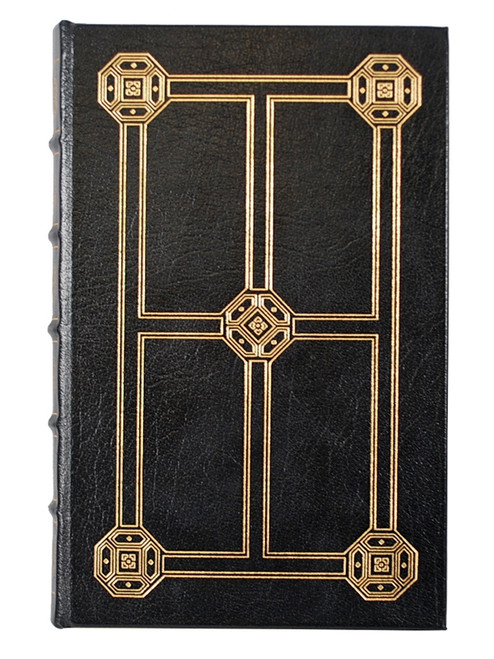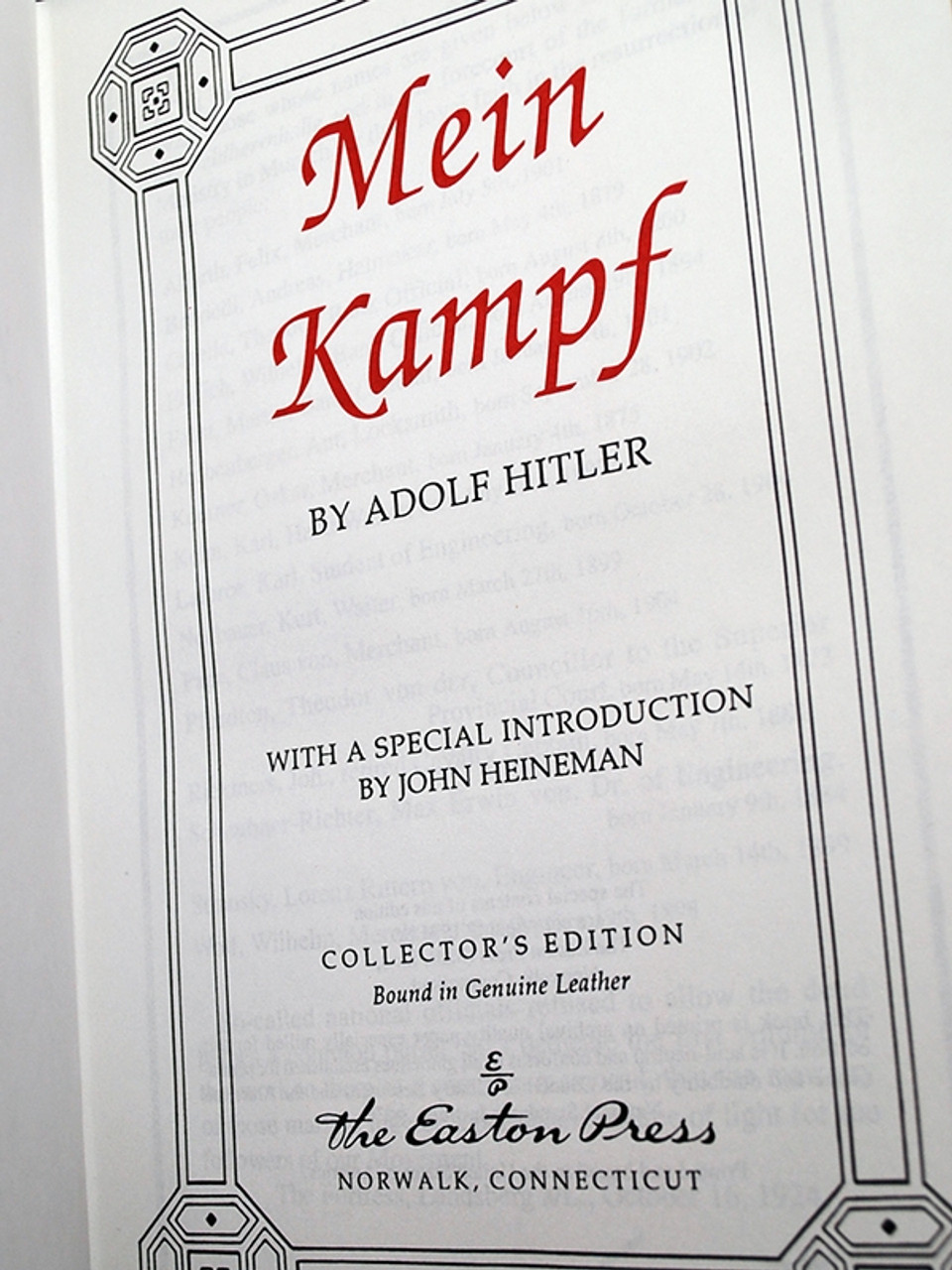A Rare Chronicle of Political History
Easton Press, Norwalk. CT. "Mein Kampf" is part of the Books That Changes The World series. A deluxe leather binding, gold-plated embellishments, and pristine gilded pages make this rare book a valuable addition to any investor's collection, no matter what your political persuasion.
Mein Kampf, (in English: "My Struggle") by Adolf Hitler, combines elements of autobiography with an exposition of Hitler's political ideology. Hitler wrote much of Mein Kampf while imprisoned for political treason. After he was released from prison and assumed a political leadership role in 1933, his biography was available to the public in three editions. It was originally published in two volumes (the first in 1925 and another in 1926). In 1939, a limited-edition anniversary version was issued to commemorate the author's 50th birthday.
Easton Press 1994. 484 pages.
Includes the classic Easton Press qualities:
* Premium Leather
* Silk Moire Endleaves
* Distinctive Cover Design
* Hubbed Spine, Accented in Real 22KT Gold
* Satin Ribbon Page Marker
* Gilded Page Edges
* Long-lasting, High Quality Acid-neutral Paper
* Smyth-sewn Pages for Strength and Durability
* Beautiful Illustrations
Contents:
Vol 1: A retrospect:
1. In the home of my parents.
2. Years
of study and suffering in Vienna.
3. Political reflections arising out
of my sojourn in Vienna.
4. Munich.
5. The world war.
6. War
propaganda.
7. The revolution.
8. The beginning of my political
activities.
9. The German Labor Party.
10. Race and people.
11. The
first stage in the development of the German National Socialist Labor
Party.
Vol 2: The National Socialist Movement:
1. Weltanschauung and
party.
2. The state.
3. Citizens and subjects of the state.
4.
Personality and the ideal of the people's party.
5. Weltanschauung and
organization.
6. The first period of our struggle.
7. The conflict with
the red forces.
8. The strong is strongest when alone.
9. Fundamental
ideas regarding the organization of the storm troops.
10. The mask of
federalism.
11. Propaganda and organization.
12. The problem of the
trade unions.
13. The German post-war policy of alliances.
14.
Germany's policy in eastern Europe.
15. The right to self-defence.
Review
The angry ranting of an obscure, small-party politician, the first volume of Mein Kampf
was virtually ignored when it was originally published in 1925.
Likewise the second volume, which appeared in 1926. The book details
Hitler's childhood, the "betrayal" of Germany in World War I, the
desire for revenge against France, the need for
lebensraum for
the German people, and the means by which the National Socialist party
can gain power. It also includes Hitler's racist agenda and his
glorification of the "Aryan" race.
The few outside the Nazi party who
read it dismissed it as nonsense, not believing that anyone could--or
would--carry out its radical, terrorist programs. As Hitler and the
Nazis gained power, first party members and then the general public
were pressured to buy the book. By the time Hitler became chancellor of
the Third Reich in 1933, the book stood atop the German bestseller
lists. Had the book been taken seriously when it was first published,
perhaps the 20th century would have been very different.
Beyond the anger, hatred, bigotry, and self-aggrandizing, Mein Kampf
is saddled with tortured prose, meandering narrative, and tangled
metaphors (one person was described as "a thorn in the eyes of venal
officials"). That said, it is an incredibly important book. It is
foolish to think that the Holocaust could not happen again, especially
if World War II and its horrors are forgotten. As an Amazon.com reader
has pointed out, "If you want to learn about why the Holocaust
happened, you can't avoid reading the words of the man who was most
responsible for it happening."
Mein Kampf, therefore, must be read as a reminder that evil can all too easily grow.
- Publisher:
- Easton Press
- Edition:
- Limited Edition
- Binding:
- Full Genuine Leather
- Illustrator:
- see product description
- Dimensions:
- 9.5" x 6" x 1.5"
















![Easton Press, Theodore Gray "Molecules" Deluxe Leather Bound Limited Edition [Sealed] Easton Press, Theodore Gray "Molecules" Deluxe Leather Bound Limited Edition [Sealed]](https://cdn11.bigcommerce.com/s-eohzfjch7f/images/stencil/500x659/products/283/1274/178-121-2__02850.1601670153.jpg?c=1)

![Easton Press, J.R.R. Tolkien "The Fall of Arthur" Leather Bound Collector's Edition, Limited Edition [Sealed] Easton Press, J.R.R. Tolkien "The Fall of Arthur" Leather Bound Collector's Edition, Limited Edition [Sealed]](https://cdn11.bigcommerce.com/s-eohzfjch7f/images/stencil/500x659/products/334/1521/215-112-2__70590.1601670221.jpg?c=1)
![Easton Press, Leon Uris "Exodus" Signed Limited Edition, Leather Bound [Sealed] Easton Press, Leon Uris "Exodus" Signed Limited Edition, Leather Bound [Sealed]](https://cdn11.bigcommerce.com/s-eohzfjch7f/images/stencil/500x659/products/386/1912/400-108-2__63380.1601670321.jpg?c=1)
![Easton Press "Snow White And The Seven Dwarves" Limited Edition, Leather Bound Collector's Edition [Sealed] Easton Press "Snow White And The Seven Dwarves" Limited Edition, Leather Bound Collector's Edition [Sealed]](https://cdn11.bigcommerce.com/s-eohzfjch7f/images/stencil/500x659/products/2241/8913/snow_white-1__27856.1615639120.jpg?c=1)
